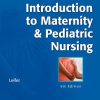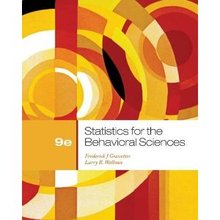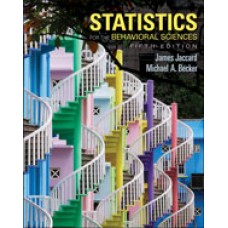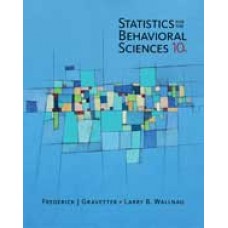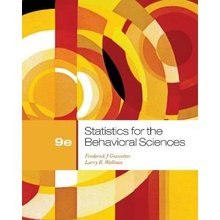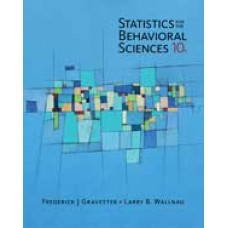Test Bank for Basic Statistics for the Behavioral Sciences, 7th Edition
$35.00 Original price was: $35.00.$26.50Current price is: $26.50.
Test Bank for Basic Statistics for the Behavioral Sciences, 7th Edition
This is completed downloadable of Test Bank for Basic Statistics for the Behavioral Sciences, 7th Edition
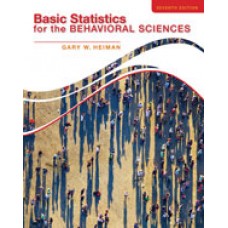
Product Details:
- ISBN-10 : 1285055748
- ISBN-13 : 978-1285055749
- Author: Gary Heiman
Packed with real-world illustrations and the latest data available, BASIC STATISTICS FOR THE BEHAVIORAL SCIENCES, 7E, International Edition demystifies and fully explains statistics in a lively, reader-friendly format. The author’s clear, patiently crafted explanations with an occasional touch of humor, teach readers not only how to compute an answer but also why they should perform the procedure or what their answer reveals about the data. Offering a conceptual-intuitive approach, this popular book presents statistics within an understandable research context, deals directly and positively with potential weaknesses in mathematics, and introduces new terms and concepts in an integrated way.
Table of Content:
- Ch 1: Introduction to Statistics
- Getting Started
- Introduction
- Why is it Important to Learn Statistics (and how do I do that?)
- Review of Mathematics Used in Statistics
- Putting it all Together
- Chapter Summary
- Key Terms
- Review Questions
- Application Questions
- Ch 2: Statistics and the Research Process
- Getting Started
- Introduction
- The Logic of Research
- Applying Descriptive and Inferential Statistics
- Understanding Experiments and Correlational Studies
- The Characteristics of Scores
- Statistics in Published Research: Using Statistical Terms
- Putting it all Together
- Chapter Summary
- Key Terms
- Review Questions
- Application Questions
- Ch 3: Frequency Distributions and Percentiles
- Getting Started
- Introduction
- New Statistical Notation
- Why is it Important to know about Frequency Distributions?
- Simple Frequency Distributions
- Types of Simple Frequency Distributions
- Relative Frequency and the Normal Curve
- Computing Cumulative Frequency and Percentile
- Statistics in Published Research: Apa Publication Rules
- A Word about Grouped Frequency Distributions
- Putting it all Together
- Chapter Summary
- Key Terms
- Review Questions
- Application Questions
- Integration Questions
- Summary of Formulas
- Ch 4: Measures of Central Tendency: The Mean, Median, and Mode
- Getting Started
- Introduction
- New Statistical Notation
- Why is it Important to know about Central Tendency
- What is Central Tendency
- The Mode
- The Median
- Transformations and the Mean
- Deviations around the Mean
- Describing the Population Mean
- Summarizing Research
- Statistics in Published Research: Using the Mean
- Putting it all Together
- Chapter Summary
- Key Terms
- Review Questions
- Application Questions
- Integration Questions
- Summary of Formulas
- Ch 5: Measures of Variability: Range, Variance, and Standard Deviation
- Getting Started
- Introduction
- New Statistical Notation
- Why is it Important to know about Measures of Variability?
- Understanding the Variance and Standard Deviation
- The Population Variance and the Population Standard Deviation
- A Summary of the Variance and Standard Deviation
- Computing Formulas for the Variance and Standard Deviation
- Applying the Variance and Standard Deviation to Research
- Statistics in Published Research: Reporting Variability
- Putting it all Together
- Chapter Summary
- Key Terms
- Review Questions
- Application Questions
- Integration Questions
- Summary of Formulas
- Ch 6: z-Scores and the Normal Curve
- Getting Started
- Introduction
- New Statistical Notation
- Why is it Important to know about z-Scores?
- Understanding z-Scores
- Interpreting z-Scores Using the z-Distribution
- Using z-Scores to Compare Different Variables
- Using z-Scores to Determine the Relative Frequency of Raw Scores
- Statistics in Published Research: Using z-Scores
- Using z-Scores to Describe Sample Means
- Putting it all Together
- Chapter Summary
- Key Terms
- Review Questions
- Application Questions
- Integration Questions
- Summary of Formulas
- Ch 7: The Correlation Coefficient
- Getting Started
- Introduction
- New Statistical Notation
- Why is it Important to know about Correlation Coefficients?
- Understanding Correlational Research
- Types of Relationships
- Strength of the Relationship
- The Pearson Correlation Coefficient
- The Spearman Rank-Order Correlation Coefficient
- The Restriction of Range Problem
- Statistics in Published Research: Correlation Coefficients
- Putting it all Together
- Chapter Summary
- Key Terms
- Review Questions
- Application Questions
- Integration Questions
- Summary of Formulas
- Ch 8: Linear Regression
- Getting Started
- Introduction
- New Statistical Notation
- Why is it Important to know about Linear Regression?
- Understanding Linear Regression
- The Linear Regression Equation
- The Standard Error of the Estimate
- Computing the Proportion of Variance Accounted for
- A Word About Multiple Correlation and Regression
- Statistics in Published Research: Linear Regression
- Putting it all Together
- Chapter Summary
- Key Terms
- Review Questions
- Application Questions
- Integration Questions
- Summary of Formulas
- Halfway Review
- Introduction
- Ch 9: Using Probability to Make Decisions about Data
- Getting Started
- Introduction
- New Statistical Notation
- Why is it Important to know about Probability?
- The Logic of Probability
- Computing Probability
- Obtaining Probability from the Standard Normal Curve
- Random Sampling and Sampling Error
- Deciding Whether a Sample Represents a Population
- Putting it all Together
- Chapter Summary
- Key Terms
- Review Questions
- Application Questions
- Integration Questions
- Summary of Formulas
- Ch 10: Introduction to Hypothesis Testing
- Getting Started
- Introduction
- New Statistical Notation
- Why is it Important to know about the z-Test?
- The Role of Inferential Statistics in Research
- Setting Up Inferential Procedures
- Performing the z-Test
- Interpreting Significant Results
- Interpreting Nonsignificant Results
- Summary of the z-Test
- The One-Tailed Test
- Errors in Statistical Decision Making
- Statistics in Published Research: Reporting Significance Tests
- Putting it all Together
- Chapter Summary
- Key Terms
- Review Questions
- Application Questions
- Integration Questions
- Summary of Formulas
- Ch 11: Performing the One-Sample t-Test and Testing Correlation Coefficients
- Getting Started
- Introduction
- Why is it Important to know about t-Tests?
- Performing the One-Sample t-Test
- Estimating µ by Computing a Confidence Interval
- Statistics in Published Research: Reporting the t-Test
- Significance Tests for Correlation Coefficients
- Maximizing the Power of Statistical Tests
- Putting it all Together
- Chapter Summary
- Key Terms
- Review Questions
- Application Questions
- Integration Questions
- Summary of Formulas
- Ch 12: The Two-Sample t-Test
- Getting Started
- Introduction
- New Statistical Notation
- Why is it Important to know about the two-Sample t-Test?
- Understanding the Two-Sample t-Test
- The Independent-Samples t-Test
- Summary of the Independent-Samples t-Test
- The Related-Samples t-Test
- Statistical Hypotheses for the Related-Samples t-Test
- Summary of the Related-Samples t-Test
- Describing the Relationship in a Two-Sample Experiment
- Statistics in Published Research: The Two-Sample Experiment
- Putting it all Together
- Chapter Summary
- Key Terms
- Review Questions
- Application Questions
- Integration Questions
- Summary of Formulas
- Ch 13: The One-Way Analysis of Variance
- Getting Started
- Introduction
- New Statistical Notation
- Why is it Important to know about ANOVA?
- An Overview of ANOVA
- Understanding the ANOVA
- Performing the ANOVA
- Performing Post HOC Comparisons
- Summary of Steps in Performing a One-Way ANOVA
- Additional Procedures in the One-Way ANOVA
- Statistics in Published Research: Reporting ANOVA
- Putting it all Together
- Chapter Summary
- Key Terms
- Review Questions
- Application Questions
- Integration Questions
- Summary of Formulas
- Ch 14: The Two-Way Analysis of Variance
- Getting Started
- Introduction
- New Statistical Notation
- Why is it Important to know about the Two-Way ANOVA?
- Understanding the Two-Way Design
- Overview of the Two-Way, Between-Subjects ANOVA
- Computing the Two-Way ANOVA
- Completing the Two-Way Experiment
- Summary of the Steps in Performing a Two-Way ANOVA
- Putting it All Together
- Chapter Summary
- Key Terms
- Review Questions
- Application Questions
- Integration Questions
- Summary of Formulas
- Ch 15: Chi Square and Other Nonparametric Procedures
- Getting Started
- Introduction
- Why is it Important to know about Nonparametric Procedures?
- Chi Square Procedures
- One-Way Chi Square
- The Two-Way Chi Square
- Statistics in Published Research: Reporting Chi Square
- Nonparametric Procedures for Ranked Data
- Putting it all Together
- Chapter Summary
- Key Terms
- Review Questions
- Application Questions
- Integration Questions
- Summary of Formulas
- Second-Half Review
- Introduction
- A: Additional Statistical Formulas
- B: Using SPSS
- C: Statistical Tables
- D: Answers to Odd-Numbered Questions
- Glossary
- Index
- IBC1
- IBC2
- IBC3
- IBC4
- IBC5
- IBC6
People Also Search:
basic statistics for the behavioral sciences 7th edition
basic statistics for the behavioral sciences 7th edition download scribd
basic statistics for the behavioral sciences 7th edition test bank download pdf



